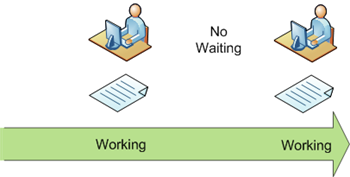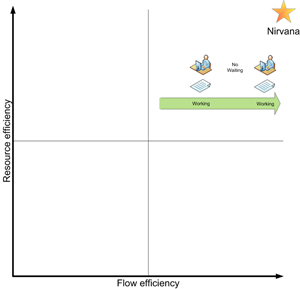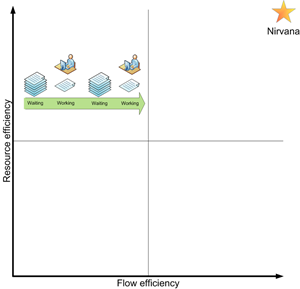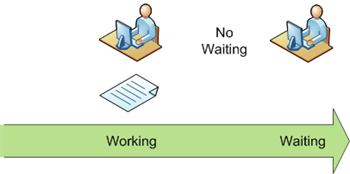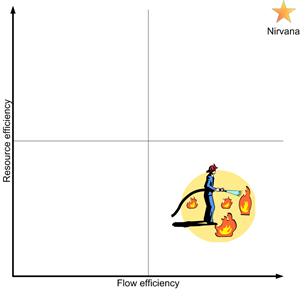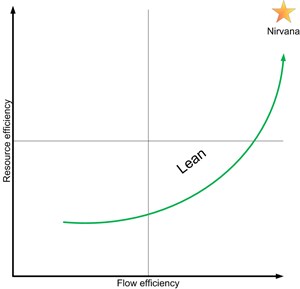What is process efficiency Nirvana?
When work flow from process step to process step without any disruption or waiting and people and resources are working at full utilization.
Figure 1. Work is flowing without any waiting and people are busy.
To get to process efficiency Nirvana you have to perfectly balance the process resource efficiency and it’s flow efficiency. You are at 100% resource efficiency and 100% flow efficiency.
Figure 2. Process efficiency Nirvana. 100% resource efficiency and 100% flow efficiency
In this post I will explore these efficiencies and how variation plays an important part in finding this perfect balance. If you manage this efficiency balancing act in your processes you can create a competitive edge.
Resource efficiency
High resource efficiency is when people and resources are working all the time without any disruptions or waiting.
Figure 3. Work is waiting to be worked on and people are busy.
Running a steel mill is an example of were high resource efficiency is good business strategy. Running a steel mill is very expensive. It is expensive to keep the smelter hot. It is even more expensive to cool it down and then getting it hot again. You are willing to take the economic burden of keeping raw material always on hand to keep the mill busy. You are even willing to finished gods in inventory to keep the mill busy.
Figure 4. Steel mill. An example were high resource efficiency is good business strategy.
Efficient use of people and resources are important. If you are not efficiently using your people and resources you are paying higher salaries than necessary and for equipment that is not being used.
To achieve high resource efficiency you must ensure that the people and resources never run out of work.
A simple and very common way to achieve this is to queue work in front of a process step. With a queue in front variation in the process can be handled and the risk that the people or the resources run out of work is minimized. The down side of queues is that they increase lead time as work waits in the queue (see Little’s Law).
Figure 5. High resource efficiency
Flow efficiency
High flow efficiency is when work flows from process step to process step without any disruption or waiting. Touch-time is at 100% and waiting time is at zero.
Figure 6. Work is flowing without any waiting and people are waiting for work.
Firefighting is one example where a very high flow efficiency is desired. If your house is on fire you don’t want to wait very long for the fire brigade to arrive and putting out the fire. You want the fire brigade to be instant available. You are even willing to pay for the firefighters to be on standby.
Figure 7. Firefighting. An example were high flow efficiency is good business strategy.
High flow efficiency results in shorter lead times. Short lead times is important as this is your time to market. Short lead times enables you to respond faster to changing market conditions and lower your risks. Shorter lead times is also good for your cash flow as you will decrease the time capital is tied up from order to payment. Shorter lead times also tightens feedback loops and can increase learning.
To achieve high flow efficiency you must ensure that work is never waiting to getting worked on.
Ensuring that work is never waiting means you can’t have work waiting in queues. To ensure that there is no queues you have to have people and resources available as work arrives. You need slack. The big down side of slack is that you are paying for salaries and for equipment that you are not using all the time.
Figure 8. High flow efficiency
Variation
Variation in a process effects your ability to reach process Nirvana. The higher the variation the harder it will be to get there.
To get to high resource efficiency you have to guard against arrival time variation. The higher the variation the larger the queues has to be to guard against being depleted. Larger queues will lower your flow efficiency and increase your lead times. The closer to full resource efficiency you are the more the lead times will increase with the variation(see Kingman’s formula).
To get to high flow efficiency you have to guard against arrival rate variation. The higher the variation the more slack you have to have. More slack in the process and you are driving down resource efficiency.
Getting to Nirvana
As you can see having both high resource efficiency and high flow efficiency are often diametrical apposed to each other. If you have any variation in your process you need queues to get high resource efficiency and you can’t have queues if you want high flow efficiency. The higher the variation is in the process the more true this diametrical problem becomes.
How do you then get to Nirvana? Can you even reach Nirvana?
Reaching process Nirvana is hard, very hard, possibly even impossible.
But even if it is impossible, striving for it will pay off. If you can have higher flow and resource efficiency than your competitors you can out perform your competitors. You need to choose a strategy to contain your variation, increase your flow efficiency without lowering your resource efficiency.
One such strategy is Lean. In a future post I will discuss how the Lean strategy strives for the process Nirvana.
Figure 9. Lean – a strategy on the path towards process efficiency Nirvana
Thank you Niklas Modig and Pär Åhlström for the great book “Vad är Lean” that inspired me to write this and future post. And thank you for letting me use this model.
I also highly recommend the book “The Principles of Product Development Flow: Second Generation Lean Product Development” by Donald G. Reinertsen
Filed under: Agile, Lean Tagged: Agile, Flow efficiency, Lean, Resource efficiency
![]()
